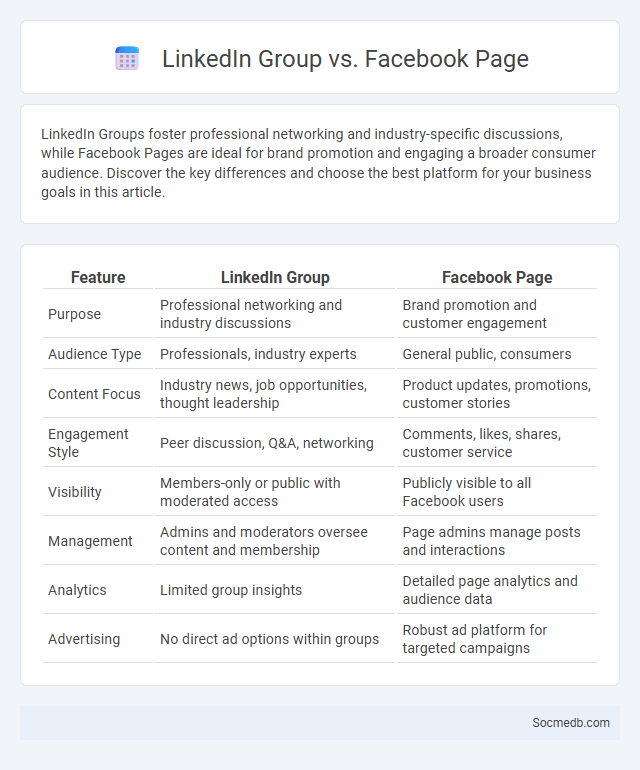
Photo illustration: LinkedIn Group vs Facebook Page
LinkedIn Groups foster professional networking and industry-specific discussions, while Facebook Pages are ideal for brand promotion and engaging a broader consumer audience. Discover the key differences and choose the best platform for your business goals in this article.
Table of Comparison
| Feature | LinkedIn Group | Facebook Page |
|---|---|---|
| Purpose | Professional networking and industry discussions | Brand promotion and customer engagement |
| Audience Type | Professionals, industry experts | General public, consumers |
| Content Focus | Industry news, job opportunities, thought leadership | Product updates, promotions, customer stories |
| Engagement Style | Peer discussion, Q&A, networking | Comments, likes, shares, customer service |
| Visibility | Members-only or public with moderated access | Publicly visible to all Facebook users |
| Management | Admins and moderators oversee content and membership | Page admins manage posts and interactions |
| Analytics | Limited group insights | Detailed page analytics and audience data |
| Advertising | No direct ad options within groups | Robust ad platform for targeted campaigns |
Understanding LinkedIn Groups, Facebook Pages, and Niche Communities
LinkedIn Groups provide a professional platform for networking, sharing industry insights, and fostering business relationships within specialized sectors. Facebook Pages allow you to build brand presence, engage with your audience through targeted content, and analyze user interactions via detailed analytics tools. Niche communities offer tailored environments where you can connect with like-minded individuals, exchange specialized knowledge, and grow your expertise within focused interest areas.
Key Features Comparison: LinkedIn Group vs Facebook Page vs Niche Community
LinkedIn Groups offer professional networking with industry-specific discussions and member-driven content ideal for B2B engagement, while Facebook Pages provide broader audience reach with customizable marketing tools and advertising options suited for brand promotion. Niche Communities focus on highly targeted interests, fostering deeper user engagement through specialized content and exclusive access, maximizing your potential for meaningful interactions. Understanding these key features helps you choose the best platform to grow your brand presence and connect with your desired audience effectively.
Audience Targeting and Community Engagement
Effective audience targeting on social media leverages advanced data analytics and user behavior insights to deliver personalized content that maximizes reach and engagement. Community engagement thrives by fostering authentic interactions through responsive communication, user-generated content, and interactive features such as polls and live sessions. Deploying these strategies enhances brand loyalty and drives meaningful connections within niche demographics.
Content Sharing and Moderation Capabilities
Social media platforms enable seamless content sharing by allowing users to upload, distribute, and engage with multimedia posts, fostering dynamic online communities. Advanced moderation capabilities utilize AI-driven algorithms and human reviewers to detect and manage harmful content, ensuring a safer user experience. Your active participation and adherence to platform guidelines contribute to maintaining a respectful and vibrant digital environment.
Branding and Professional Networking Opportunities
Social media platforms provide powerful tools for branding by enabling you to showcase your unique value proposition and engage directly with your target audience. Leveraging professional networking opportunities on LinkedIn and industry-specific groups enhances your visibility, fosters meaningful connections, and opens pathways for career growth. Consistent and strategic social media presence strengthens your brand identity and positions you as an authority in your field.
Privacy, Security, and Membership Controls
Social media platforms implement advanced privacy settings that empower users to control who can view their profiles and posts, enhancing personal data protection. Robust security measures, including two-factor authentication and encryption, safeguard accounts against unauthorized access and cyber threats. Membership controls allow users to manage friend lists, block or report suspicious activities, and customize audience settings to maintain a secure and private online environment.
Analytics and Performance Metrics
Social media analytics involve tracking key performance metrics such as engagement rate, click-through rate, and follower growth to measure campaign effectiveness and audience behavior. Platforms like Facebook Insights and Twitter Analytics provide detailed reports on user interactions, reach, and conversion rates, enabling data-driven marketing strategies. Leveraging these metrics helps optimize content, enhance brand visibility, and maximize return on investment across social networks.
Organic Reach and Algorithm Impacts
Social media organic reach refers to the number of unique users who see your content without paid promotion, heavily influenced by platform algorithms designed to prioritize relevant and engaging posts. Algorithm impacts can significantly reduce organic reach, as platforms like Facebook and Instagram favor content from friends, family, and paid advertisers over brand pages. Understanding these algorithms and creating high-quality, engaging content tailored to audience preferences is essential for maximizing organic visibility and fostering authentic user interactions.
Best Use Cases: Which Platform Suits Your Goals?
Selecting the right social media platform depends on your marketing objectives, audience demographics, and content format. Instagram excels for visual storytelling and brand engagement among younger demographics, while LinkedIn is ideal for B2B networking and professional content distribution. TikTok offers rapid organic reach with short-form video content, perfect for brand awareness and viral marketing campaigns.
Choosing the Right Platform for Your Community Strategy
Selecting the ideal social media platform hinges on understanding your community's demographics and engagement preferences. Platforms like Facebook excel in fostering diverse age groups, while Instagram and TikTok capture younger, visually-driven audiences. Tailoring content to each platform's unique algorithms and user behavior maximizes reach and strengthens community connections.
 socmedb.com
socmedb.com